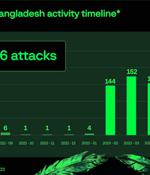Security News

The distributed nature of IoT devices renders them ideal platforms for these attacks, making it difficult to identify and block malicious traffic and thereby compounding the challenges of DDoS mitigation. Let's discuss how IoT DDoS attacks happen and how new IoT devices join the ranks of bots.

Akamai says it thwarted a major distributed denial-of-service attack aimed at a US bank that peaked at 55.1 million packets per second earlier this month. The network traffic flood hit on September 5 against the unnamed finance giant Akamai describes as "One of the biggest and most influential US financial institutions."

A new Mirai malware botnet variant has been spotted infecting inexpensive Android TV set-top boxes used by millions for media streaming. The primary targets of this campaign are low-cost Android TV boxes like Tanix TX6 TV Box, MX10 Pro 6K, and H96 MAX X3, which feature quad-core processors capable of launching powerful DDoS attacks even in small swarm sizes.

The German Federal Financial Supervisory Authority announced today that an ongoing distributed denial-of-service attack has been impacting its website since Friday. BaFin is Germany's financial regulatory authority, part of the Federal Ministry of Finance, responsible for supervising 2,700 banks, 800 financial, and 700 insurance service providers.

No miners were involved in this story Tor, which stands for The Onion Router, weathered a massive distributed denial-of-service (DDoS) storm from June last year through to May.…

As we entered 2023, the cybersecurity landscape witnessed an increase in sophisticated, high-volume attacks, according to Gcore. The maximum attack power rose from 600 to 800 Gbps. UDP flood attacks were most common and amounted to 52% of total attacks, while SYN flood accounted for 24%. In third place was TCP flood.

A hacktivist group known as Mysterious Team Bangladesh has been linked to over 750 distributed denial-of-service (DDoS) attacks and 78 website defacements since June 2022. "The group most...

Website of Israel's largest oil refinery operator, BAZAN Group is inaccessible from most parts of the world as threat actors claim to have hacked the Group's cyber systems. The Haifa Bay-based BAZAN Group, formerly Oil Refineries Ltd., generates over $13.5 billion in annual revenue and employs more than 1,800 people.

Several distributed denial-of-service botnets have been observed exploiting a critical flaw in Zyxel devices that came to light in April 2023 to gain remote control of vulnerable systems. "Through the capture of exploit traffic, the attacker's IP address was identified, and it was determined that the attacks were occurring in multiple regions, including Central America, North America, East Asia, and South Asia," Fortinet FortiGuard Labs researcher Cara Lin said.

As we entered 2023, the cybersecurity landscape witnessed an increase in sophisticated, high-volume attacks, according to Gcore. The maximum attack power rose from 600 to 800 Gbps. UDP flood attacks were most common and amounted to 52% of total attacks, while SYN flood accounted for 24%. In third place was TCP flood.